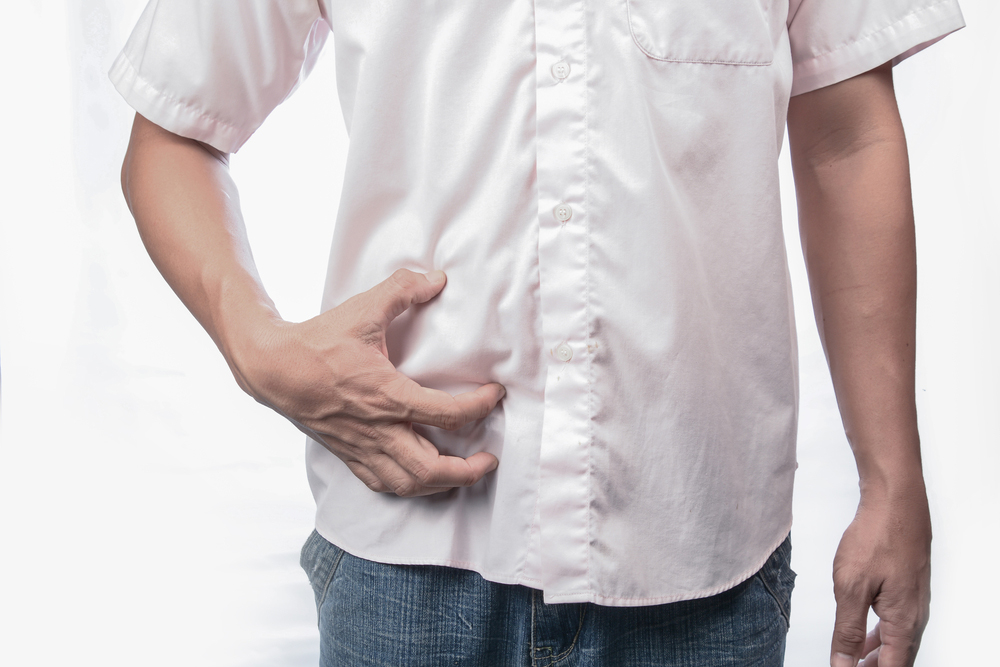
Appendicitis is an acute inflammation of the rectal process (appendix). Chronic forms of this disease are rare. Depending on the course of the disease, it may be accompanied by a disturbance in digestion and an increase in body temperature. But, the main and constant sign of appendicitis is pain, which is diverse.
The content of the article
- Where is the appendicitis, what does it look like?
- Which side does appendicitis hurt?
- Causes of appendicitis in children and adults
- At-risk groups
- Symptoms and signs of appendicitis in adults and children
- Symptoms and signs of appendicitis during pregnancy
- Types of appendicitis: phlegmonous, chronic, purulent, gangrenous
- The operation to remove appendicitis: How long does it last?
- What can be eaten after surgery for appendicitis?
- How much do they lie in a hospital with appendicitis?
- Appendicitis in adults and children. Tips and reviews
- Video. How to distinguish appendicitis from other abdominal pain?
Where is the appendicitis, what does it look like?
Almost all people have appendicitis on the right. It is the pain in the right side of the abdomen that are the main sign of inflammation of the appendicitis. In order to highly determine this disease, it is necessary:
- Press the fingers in the ilium with your fingertips on the right side. If the pain is intensified with this action, then with a high probability it can be argued that the appendix is \u200b\u200binflamed. For confidence, you can do the same action with the left side of the abdomen. If there is no pain, then this is another of the signs of appendicitis
- Pout. Usually, with the described disease, muscle contraction during coughing can cause pain in the right side of the abdomen. It can also be a signal that it is necessary to call an ambulance to receive professional assistance
- Press the palm on the ilium And wait 10 seconds. If the pain after removing the hand intensifies, then this is also one of the signs of inflammation of the appendix
- Lie on the left side. In this position, with appendicitis, the pain should decrease
Important: all of the above methods for diagnosing appendicitis at home cannot guarantee that you do not have inflammation of the appendix. Therefore, with the first symptoms of the disease, you must urgently consult your doctor.
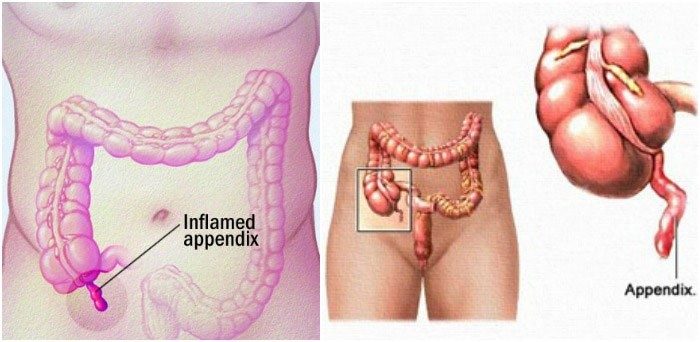
In this picture you can clearly see where the appendicitis is located in a man and a woman.
But, in a small number of people, this process of the rectum can shift both in one and the other. Sometimes there are people with a mirror arrangement of organs. In this case, the appendix will be on the left.
Which side does appendicitis hurt?
Reply from which side the appendicitis hurts is very difficult. Yes, we wrote above that the appendix of the overwhelming number of people is on the right in the lower abdomen. But, pain can “give” in other places of abdominal cavity. Localization of pain at the location of the appendix occurs already in the acute phase, when the inflammation intensifies.
There are several places, pain in which can be associated with appendicitis:
- The upper abdomen. This pain portends appendix problems. It, as a rule, occurs suddenly and gradually intensifies. After which the temperature may rise, vomiting and other symptoms of the described disease will appear
- The whole stomach. In some cases, inflammation of the appendix can be “reflected” by pain in the entire stomach. In this case, the patient's well -being deteriorates sharply
- Pelvis. With the atypical arrangement of the appendix (occurs in 30% of people), pain from inflammation can be given to the basin
- Small of the back. Sometimes the pain is reflected in the lumbar spine. Therefore, many patients initially think that they have a kidney disease
Causes of appendicitis in children and adults
Appendix is \u200b\u200ba process of rectum 9-10 cm long. In fact, it is the border between the small and large intestine. Since it consists of lymphoid tissue, it signs in the formation of intestinal immunity. That is, it helps him to cope with viruses and infections.
But, even such a role does not allow this process to call this process with a vital organ. Therefore, with any problems with the appendix, it is removed surgically. And such problems can have a different nature. Moreover, in children and adults they can vary. Inflammation of this process can appear both in a healthy person and one who suffers from chronic diseases of the gastrointestinal tract.

Until now, medicine cannot give a unambiguous answer to the question of what appendicitis appears from. Three theories dominate today in this regard:
- Mechanical causes. With frequent constipation, a blockage of the lumen of the appendix can occur with fecal masses. Therefore, people suffering from such a problem are at risk. The accumulation of feces, parasites and neoplasms in the intestines can provoke a clogging of the lumen of the appendix. This can lead to the creation of a favorable microflora for harmful organisms. What can develop into inflammation of the appendix
Important: the clearance of the process has a small diameter. Therefore, it is very easy to close it with various foreign bodies: husk from seeds, small bones, parts of destroyed teeth, etc.
- Infectious causes. With the penetration of parasitic infections into the intestines, an inflammatory process in the cecum can develop
- Improper nutrition. An unhealthy and unbalanced diet can also cause inflammation of the appendix. Especially in the risk zone are people who are fond of fried, fatty, smoked and spicy dishes. Children consuming chips, seeds and other “harmful” products in large numbers are more likely to feel all the problems associated with appendicitis
Important: specialists from the Madrid Royal Institute revealed the fact of the connection of inflammation of the appendix and the use of fried seeds. So, in almost 40% of cases of this disease, it is associated with the use of this product, as well as chips. A particularly large percentage of appendicitis associated with eating these products was observed in children.
Also, one of the causes of inflammation of the appendix are problems with blood vessels. So far, these causes of appendicitis are rather theory. At the moment, they are not fully studied and are not excluded by doctors from the causes of appendicitis
At-risk groups
Appendix inflammation can occur at any age. But, most often this ailment is manifested in people 20-30 years old, children over 5 years old and pregnant women. In young children, due to the structure of their body, as well as the elderly, due to the fact that lymphoid tissue undergoes reverse development, appendicitis is quite rare.
Symptoms and signs of appendicitis in adults and children
To pain, as the main symptom of inflammation of the appendix, nausea, vomiting and fever can be added. Such pain, as we already wrote above, can have a different nature and localized as the appendix is \u200b\u200binflamed in various places of the abdominal cavity.
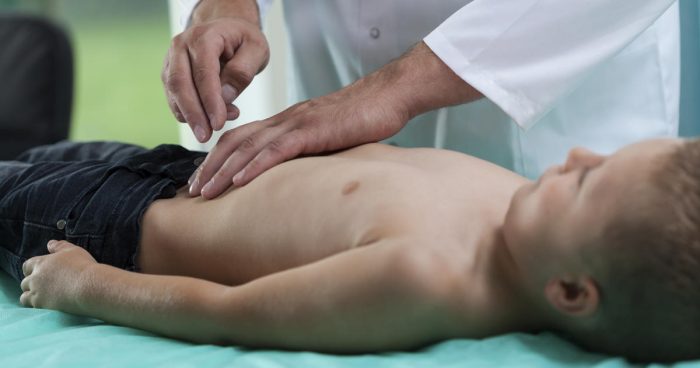
Medical examination
Important: sometimes, moderate pain in appendicitis can cause the patient to continue his life and not pay attention to it. What can lead to very serious consequences. Therefore, do not rush to take an analgesic drug, to a comprehensive examination.
As for nausea and vomiting, with an empty stomach they are accompanied by the release of liquid and yellow mucus.
The temperature that the appendicitis may be accompanied rarely exceeds 37-38 degrees.
The most dangerous symptoms of appendicitis are:
- The subsided pain, which can cause a rupture of the appendix. After a few hours, with this consequence of appendicitis, pain will appear with even greater intensity.
- Frequent and incessant vomiting
- A sharp increase or drop in temperature
- Painful sensations and tension of the abdominal muscles
- Loss of consciousness
Important: in addition to pain, a constant thirst is a frequent sign of appendicitis in children. Touch the baby's stomach. If he shudders sharply, he will begin to scream and cry that this can signal the presence of the problem described. The temperature with inflammation of the appendix in children does not always increase.
Symptoms and signs of appendicitis during pregnancy
Inflammation of the appendix during pregnancy is a fairly common occurrence. According to statistics, appendicitis was observed in 3.5% of pregnant women. Which is a rather impressive figure for this disease.
On the one hand, pregnancy can lead to this problem (the uterus, increased in size, squeezes the appendix, which leads to inflammation of the appendix), and on the other, “disguise” the symptoms. Women associate the appearance of pain in the abdominal cavity with their delicate position.
Symptoms of appendicitis in pregnant women are the same. This is pain, vomiting and stomach disorder. If a woman who is waiting for a child will fall on the right side and at the same time the pain increases, then this can increase the likelihood of this disease. In this position, the uterus will put pressure on the inflamed process, increasing the pain.
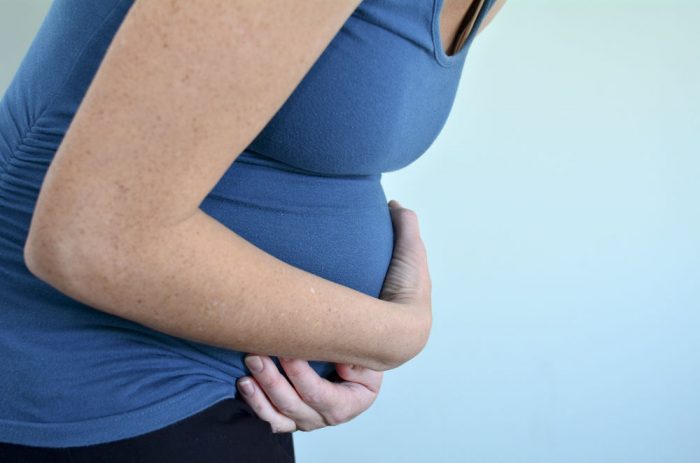
Appendicitis can negatively affect the unborn child
Especially if this disease showed itself on the second and especially the third trimester of pregnancy. Inflammation of the appendix can lead to intrauterine infection of the fetus. Therefore, in addition to removing the inflamed process, antibacterial therapy is required.
You can diagnose appendicitis in a pregnant woman using urine analysis (increased levels of leukocytes) and ultrasound examinations. A more modern method for identifying this disease is laparoscopy. Using this procedure, you can not only accurately diagnose the problem, but also remove appendicitis without cutting the abdominal wall.
Types of appendicitis: phlegmonous, chronic, purulent, gangrenous
Appendicitis, depending on the duration of spasms, their strength and other factors, differs in several forms. Each form of this disease has its own nuances in treatment.
Phlegmose
The most serious stage of the disease. With phlegm -appendicitis, the process thickens and increases in size. In the area of \u200b\u200binflammation, the patient has severe suppuration. This form of appendicitis can lead to a rupture of appendix and a lethal outcome. If the inflamed process bursts, then this can lead to serous peritonitis-a severe disease of a purulent-inflammatory nature.
CHRONIC
Not all doctors distinguish this form of appendicitis in a separate disease. According to statistics, only 1% of appendix inflammation flows into a chronic form. Signs of the disease have a similar form with acute appendicitis, but at the same time, inflammatory processes can take a rather long period of time without the risk of rupture of the appendix.
Unlike acute appendicitis, which proceeds within a few hours, the chronic form can be observed for years. It is accompanied by moderate pains, to which the patient gets used to after a while and does not pay attention to the bottom.
Chronic appendicitis is treated with a surgical method.
PURULENT
This form of appendicitis is an inflammatory process in a worm -shaped process accompanied by severe pain, vomiting and fever. This form of inflammation of the appendix has several stages and the phlegmose -described above, is the most dangerous.
In order for the infection not to other abdominal organs, the patient must be operated on timely.
GANGRENOUS
This form of appendix is \u200b\u200bthe last stage of purulent appendicitis. The danger of this stage is that the walls of the process can break and pus will fall into the abdominal cavity. What can lead to pernicious consequences.
For the successful treatment of gangrenous appendicitis, it is important to contact a specialist as soon as possible. In medical practice, there are cases when Gangrene appeared already 5-6 hours after the first symptoms.
With gangrenous appendicitis, not only the cells of the process of the process, but also the nerve endings can freeze. Because of this, the pain is dulled and the patient goes to the doctor late. What only exacerbates the problem.
The operation to remove appendicitis: How long does it last?
For the first time, an appendicitis removal operation was carried out in 1888. Today, this operation is quite common in surgical practice and is carried out almost without risk to health. Such an operation in the vast majority of cases is the only way to get rid of the described disease.
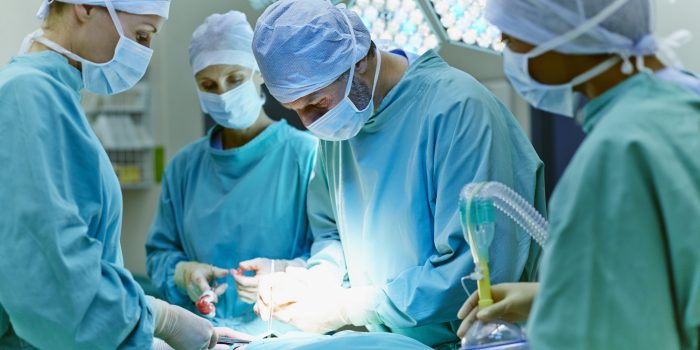
It can be carried out according to plan or emergency
Emergency surgery is carried out in acute forms of appendicitis. As a rule, it is carried out 2-3 hours after the patient enters the hospital. A planned operation is carried out after preparing for it the patient.
There are no regulations for the removal of appendicitis. It can last 40 minutes - 3 hours. The duration of this operation depends on the complexity of inflammation, the location of the process and other factors.
What can be eaten after surgery for appendicitis?
After surgical intervention and anesthesia, the patient’s body, as well as its digestive system, is subjected to great stress. It can be minimized using a special diet. It is divided into several stages, depending on the time of recovery.
First 24 hours after surgery
On the first day after surgery, the patient is usually not up to eating. Anesthesia, as well as the consequences of an inflamed appendix, negatively affect nutrition. But, the restoration of the body after the “shock” is impossible without taking useful products. And on the first day after surgery, they should enter the body with fluids. It is best if it is warm tea, berry compotes, jelly and ordinary water.
You can switch to more solid blowing only with the permission of the attending physician.
The second and third day after surgery
On the second day after removing the appendix, the patient, as a rule, can be eaten by low -fat broths. If the patient can be protein, then doctors will allow him to include yogurt and other dairy products of soft consistency in the diet.
In addition to compotes and tea on the second day, a patient can use non -acidic juices.
IMPORTANT: Eating after surgery is necessary in small portions several times a day. The inclusion of certain products in your diet must be agreed with your attending physician.
3-7 days after surgery
After the first three days of recovery after such an operation, his patient can diversify his diet with steamed dried fruits, boiled vegetables, chicken broths and various cereals prepared on the water. The doctor may allow boiled chicken or fish without bones.
How much do they lie in a hospital with appendicitis?
If the operation has passed without complications and the patient is restored according to normal graphics, then in the hospital they are no more than 1.5 weeks. Usually on 3-4 days the doctor may allow the patient to get out of bed. If there is a risk of seam discrepancy, then the patient can be prescribed by wearing a bandage.
Usually the seams are removed for 7-10 days. And after this the patient is discharged from the hospital. Then he is recommended to abandon physical tension.
Appendicitis in adults and children. Tips and reviews
Ivan. I was removed by appendicitis in my student years. The doctor advised a diet: chicken and vegetable broths, compotes, jelly and porridge without milk. I recovered somewhere a month after the operation. At the same time, the doctor said that my body did it faster than normal.
Irina. When I had a suspicion of appendicitis, I drank ketorol to relieve pain. When she said, he almost fell from his chair. He says that analgesics can “score” pain and you can “oversleep” appendicitis. You can only take navigation spasmolytics like No-Shpa.
